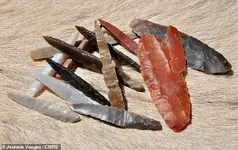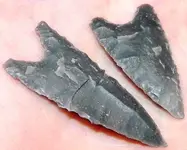uniface
Silver Member
- Joined
- Jun 4, 2009
- Messages
- 3,216
- Reaction score
- 2,905
- Golden Thread
- 0
- Location
- Central Pennsylvania
- Primary Interest:
- Other
Upvote
0
Ever heard of Japheth? Explains a lot.

Google has a ton of links somebody motivated to could check -- maybe some with additional pictures. But from only what's shown above, it's pretty clear that what they're calling "points" were cores -- points were made from channel flakes from these.
Charlie . . . ?

Google has a ton of links somebody motivated to could check -- maybe some with additional pictures. But from only what's shown above, it's pretty clear that what they're calling "points" were cores -- points were made from channel flakes from these.
Charlie . . . ?
I was thinking the same thing. After mostly reading through the paper (thanks for that link, charls!), I still think it. Those "bifaces" are flake cores. When they couldn't get any more large flakes off they used the thickness remaining in the middle of the biface to try to get one more good flake from the end. If the exhausted core was thin enough, they then sometimes pressure flaked it into an arrowhead as well, with the "flute" still in it. In that sense it is like the Clovis platters we recently discussed: It is first and foremost a bifacial flake core, then the core itself can be used as a tool/point blank.
The resulting arrowheads are interesting. The paper says averages of 60-70 mm long, 5.5 mm wide and 5 mm thick, so basically a sharpened spike. (For those having trouble picturing it, 25 mm is 1 inch.) Such a point would outright suck for big game hunting. Penetration would be superb, but the wound track would be so small the critter would be miles away before it bled out. The only reason I can think of to make a point like that is to punch through something very tough. I believe these were likely armor piercing tips, intended for use in warfare against an enemy wearing leather armor. In other words, these work sites were basically munitions factors. That being the case the idea that their knappers were intentionally using a more difficult technique just to show off is nutty. They needed a weapon that was good enough, then they needed to crank them out as fast and as easily as possible.
Probably larger. Key difference is that they're unifaces.
